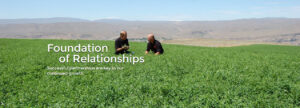Managing the diet of laminitis-prone horses can be challenging. In an earlier blog article, we briefly discussed that these types of horses should be fed diets that are low in non-structural carbohydrates (NSC). They should never be fed high-starch concentrates such as oats, dry COB, or COB with molasses. Instead, laminitis-prone horses should be fed hay that contains a low level of NSC or water-soluble carbohydrates (WSC). A feed analysis may not specifically list NSC. However, NSC is the sum of WSC and starch, both of which should be provided on a feed analysis report. Water-soluble carbohydrates include fructans and the simple sugars; glucose, fructose, and sucrose. Current research indicates that overconsumption of hays and pasture grasses that contain high levels of fructans and fructose (which is a major component of fructan), can lead to bouts of painful laminitis, especially in horses that are predisposed to the disorder.
Many common grasses harvested for hay are cool-season grasses, which tend to accumulate high levels of WSC. Therefore, some type of treatment must be applied to reduce the WSC of hay. Fortunately, soaking hay in water leaches WSC from hay. Previously reported research looked at soaking hay in very large volumes of water, or the investigators used chopped hay in their experiments. Using large quantities of water or chopping hay are not practical methods for the average horse owner to
Managing the diet of laminitis-prone horses can be challenging. In an earlier blog article, we briefly discussed that these types of horses should be fed diets that are low in non-structural carbohydrates (NSC). They should never be fed high-starch concentrates such as oats, dry COB, or COB with molasses. Instead, laminitis-prone horses should be fed hay that contains a low level of NSC or water-soluble carbohydrates (WSC). A feed analysis may not specifically list NSC. However, NSC is the sum of WSC and starch, both of which should be provided on a feed analysis report. Water-soluble carbohydrates include fructans and the simple sugars; glucose, fructose, and sucrose. Current research indicates that overconsumption of hays and pasture grasses that contain high levels of fructans and fructose (which is a major component of fructan), can lead to bouts of painful laminitis, especially in horses that are predisposed to the disorder.
Many common grasses harvested for hay are cool-season grasses, which tend to accumulate high levels of WSC. Therefore, some type of treatment must be applied to reduce the WSC of hay. Fortunately, soaking hay in water leaches WSC from hay. Previously reported research looked at soaking hay in very large volumes of water, or the investigators used chopped hay in their experiments. Using large quantities of water or chopping hay are not practical methods for the average horse owner to decrease WSC in hay. Rather, soaking flakes of hay in manageable volumes of water is preferable.
A group of researchers from the UK published a paper last year regarding hay soaking. They reported the degree of WSC leaching after soaking cool-season grasses (such as timothy, ryegrass, and meadow grass) in tap water for increasing time intervals. They removed flakes that weighed roughly 4.5 pounds from bales and either shook the hay loose or left the flake intact. They then soaked the hays in about 6 gallons of cool tap water. This amount of water completely submerged the hay. Hays were sampled after 20 minutes, 40 minutes, 3 hours, and 16 hours of soaking. Dry matter (DM) and WSC concentrations were then determined in each sample and compared to the WSC content of the hays that were not soaked in water.
 Obviously, the DM content of the hays decreased rapidly as they soaked up water (Figure 1). On average, DM decreased about 70% in the first 20 minutes of soaking. The DM was further decreased as soaking time increased. Water soluble carbohydrates in all hays decreased after soaking in water. The amount of WSC lost was variable depending on hay type, but losses averaged 5%, 9%, 16%, and 27% after 20 minutes, 40 minutes, 3 hours, and 16 hours of soak time, respectively (Figure 1). Surprisingly, the loose hay and the compacted hay in flakes lost similar amounts of WSC. Therefore, a horse owner can effectively lower WSC in a flake of hay without needing to loosen it before soaking it in water.
Obviously, the DM content of the hays decreased rapidly as they soaked up water (Figure 1). On average, DM decreased about 70% in the first 20 minutes of soaking. The DM was further decreased as soaking time increased. Water soluble carbohydrates in all hays decreased after soaking in water. The amount of WSC lost was variable depending on hay type, but losses averaged 5%, 9%, 16%, and 27% after 20 minutes, 40 minutes, 3 hours, and 16 hours of soak time, respectively (Figure 1). Surprisingly, the loose hay and the compacted hay in flakes lost similar amounts of WSC. Therefore, a horse owner can effectively lower WSC in a flake of hay without needing to loosen it before soaking it in water.
Most importantly, fructan levels were decreased after hay was soaked in water (Figure 2). On average, the fructan contents were 21% lower after the hays were soaked in water for 3 hours. Fructan levels were only slightly lower when hays were soaked for 16 hours. In addition, crude protein was not leached from the hay during soaking. Mineral and vitamin compositions of the hays were not analyzed and warrant further investigation as horses may require additional supplements when they are fed hays that have been soaked in water.
In summary, soaking grass hays in water removes WSC, including fructan, which has been implicated as a causative factor in laminitis. An 1100-pound horse fed at 2% of its bodyweight per day requires 22 pounds of DM per day. Results from the UK study suggest that WSC can be leached from 22 pounds of cool-season grass hay (DM-basis) after soaking flakes in about 30 gallons of water for at least 3 hours. However, whether this treatment will reduce WSC sufficiently for safe feeding to laminitis-prone horses can only be confirmed by laboratory analyses.
If you would like to receive this blog from Anderson Hay in your email, please subscribe above to the right.

Reference
Longland, A.C., C. Barfoot, and P.A. Harris. 2011. Effects of soaking on the water-soluble carbohydrate and crude protein content of hay. Vet. Record. 168:618-622.decrease WSC in hay. Rather, soaking flakes of hay in manageable volumes of water is preferable.
A group of researchers from the UK published a paper last year regarding hay soaking. They reported the degree of WSC leaching after soaking cool-season grasses (such as timothy, ryegrass, and meadow grass) in tap water for increasing time intervals. They removed flakes that weighed roughly 4.5 pounds from bales and either shook the hay loose or left the flake intact. They then soaked the hays in about 6 gallons of cool tap water. This amount of water completely submerged the hay. Hays were sampled after 20 minutes, 40 minutes, 3 hours, and 16 hours of soaking. Dry matter (DM) and WSC concentrations were then determined in each sample and compared to the WSC content of the hays that were not soaked in water.
Obviously, the DM content of the hays decreased rapidly as they soaked up water (Figure 1). On average, DM decreased about 70% in the first 20 minutes of soaking. The DM was further decreased as soaking time increased. Water soluble carbohydrates in all hays decreased after soaking in water. The amount of WSC lost was variable depending on hay type, but losses averaged 5%, 9%, 16%, and 27% after 20 minutes, 40 minutes, 3 hours, and 16 hours of soak time, respectively (Figure 1). Surprisingly, the loose hay and the compacted hay in flakes lost similar amounts of WSC. Therefore, a horse owner can effectively lower WSC in a flake of hay without needing to loosen it before soaking it in water.
Most importantly, fructan levels were decreased after hay was soaked in water (Figure 2). On average, the fructan contents were 21% lower after the hays were soaked in water for 3 hours. Fructan levels were only slightly lower when hays were soaked for 16 hours. In addition, crude protein was not leached from the hay during soaking. Mineral and vitamin compositions of the hays were not analyzed and warrant further investigation as horses may require additional supplements when they are fed hays that have been soaked in water.
In summary, soaking grass hays in water removes WSC, including fructan, which has been implicated as a causative factor in laminitis. An 1100-pound horse fed at 2% of its bodyweight per day requires 22 pounds of DM per day. Results from the UK study suggest that WSC can be leached from 22 pounds of cool-season grass hay (DM-basis) after soaking flakes in about 30 gallons of water for at least 3 hours. However, whether this treatment will reduce WSC sufficiently for safe feeding to laminitis-prone horses can only be confirmed by laboratory analyses.
If you would like to receive this blog from Anderson Hay in your email, please subscribe above to the right.
Reference
Longland, A.C., C. Barfoot, and P.A. Harris. 2011. Effects of soaking on the water-soluble carbohydrate and crude protein content of hay. Vet. Record. 168:618-622.


